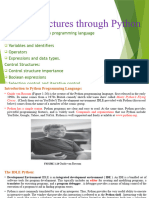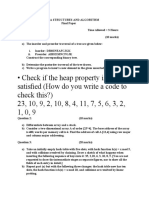Python QRG
Uploaded by
CromeXzaPython QRG
Uploaded by
CromeXzaPYTHON: QUICK REFERENCE GUIDE P YTHON : Q UICK R EFERENCE G UIDE
AE1106 Programming I TU DELFT (Updated 2011-11)
Assignment statement:
Uses simply the = sign. Expression on right side determines type of variable (this is called implicit declaration). Examples: a=4 i = i + 1
(in math this would be nonsense but it is a common statement)
Variable Types
TYPE INTEGER FLOAT STRING BOOLEAN/LOGICAL CONTAINS Whole numbers All real numbers Text Switch/condition EXAMPLES 24 -2 12.5 0.5 .5 1. 1.0 1e6 Hello world True False OPERATIONS EXAMPLES 7/3 25%4 2+3 2-3 6*4 2**3 7./3. 25.%4. 2.+3. 2.-3. 6.*4. 2.**3. Hell + o world chr(84) + chr(85) + chr(68) ord(A) a>b a<=b a==b a<>b a!=b (a==b) or (a==c) swfound and not swcorrect
Conversion of types
int(x)
converts a float to an integer (truncated), so int(3.7) is 3, int(-2.5) gives -2 float(i) to convert integer to a float variable type str(a) or repr(a) converts a number to a string, normal or resp. maximum precision eval(txt) to get the value of the content of the string (can contain variable names)
Naming of variables
Variable names can contain numbers, characters and underscore character ( _ ), Names cannot start with a number. Though not required, by convention i, j, k, l, m, n are often used of integers as well as names starting with these characters. (e.g. ncount meaning number of counts)
Page 1
PYTHON: QUICK REFERENCE GUIDE
Lists (and Tuples)
a = [5, 15, 24, -3, 7, 18, 24 , 0, 0 ,1] After this assignment then: len(a) is 10 value of a[0] is 5 value of a[9] is 1 so indices range from 0 till 9! value of a[1:4] is [15,24,-3] this is called slicing, works also on strings Adding an element can be done in two ways: with append function or with + operator. Safest way is append, especially with adding content of variables a.append(3) a.append(i) a = a+[3] b = [[3,4,5].[4,5,6]] #list of two lists c = a[3] + b[1][0] A tuple is a special list, immutable (=cannot be changed) and assignment is done with normal brackets: black = (0,0,0) green = (0,255,0) then green[1] is 255 >>>>>By default: use lists! (now with square brackets because it is an index! )
U SING
MATH FUNCTIONS
You can use math functions from the supplied math library in two ways:
M ET HO D 1:
import math a = 50.*math.pi/180. x = math.sin(a) (only once at the beginning of your program file)
M ET HO D 2:
from math import pi,sin a = 50.*pi/180 x = sin(a) Not recommended (why not?) but also possible: from math import * a = 50.*pi/180 x = sin(a)
Page 2
PYTHON: QUICK REFERENCE GUIDE
P ROGRAM
FILE LAY - OUT
A lot of time of programming is spent debugging, so make your files readable for yourself and for others. Use a lot of comment lines, they are marked with a hash character ( # ). Use the hash sign at the beginning of a comment line or at the end of a program line. You can continue on the next line with your statement by ending the line with a backslash ( \ ) as a continuation mark. Sometimes it is automatically done (in lists for example). In print statements just add a comma at the end of a line to continue on the same line with the next print statement) Use also plenty of empty lines and spaces to enhance readability as well as clear but not too long variable names. Basic statements PRINT print Hello world print The answer is ,a print Two solutions are,x1,and,x2
INPUT
Input function recognizes type of variable based on input, use raw_input() for string. a = input(Give value of a:) name = raw_input(What is your name?)
IF-statement
Use of ELSE or ELIF (else-if) is optional, always end with : to indicate start of block or statement Indenting margin determines begin and end of block! if a < b: print "a smaller than b" c=b elif a == b: print "a and b are equal" c=a else: print "a is larger than b" c=a
Page 3
PYTHON: QUICK REFERENCE GUIDE
FOR-statement For example to loop 10 times: for i in range(10): x = x + i*4 print i = ,i
range function: range(end) range(start,end) range(start,end,step) default start is zero and end is not included! Examples:
range(5) range(3,10) range(10,0,-1)
equals [0,1,2,3,4] equals [3,4,5,6,7,8,9] equals [10,9,8,7,6,5,4,3,2,1]
WHILE-statement Loop while a condition is True, note again use of semicolon and indenting:
WHILE a[i]!=b and i<len(a): i = i+1 print Checking element,i
D EFINING
AND USIN G FU NCTIONS IN SAME FILE ( OR IN SHELL ):
def faculteit(n): fac = 1 for i in range(1,n+1): fac = fac*i return fac a = input(Give number for factorial:) print Factorial ,a, = ,faculteit(a)
D EFINING
AND USIN G FU NCTIONS IN DIFFERENT FILES ( MODULES ):
In file mytools.py: def faculteit(n): fac = 1 for i in range(1,n+1): fac = fac*i return fac
Page 4
PYTHON: QUICK REFERENCE GUIDE
In file myprog.py we put the import statement in the header, the function can then be used throughout file:
import mytools f = mytools.faculteit(a) or: from mytools import faculteit f = faculteit(a)
or: from mytools import faculteit as factorial f = factorial(a)
or: import mytools.faculteit as factorial or: from mytools import *
C HECK OUT THE MANY H ELP FUNCTIONS
MODULES SUPPLIED WIT H
P YTHON
AND
There is a saying Python is free as in free beer and in free speech and it comes with batteries included. This means among other things that there is a whole list of standard modules supplied next to the basic math module.
To see which ones you have, type the following in the shell: >>>help() [welcome text interactive help] help>modules and you will see a list of modules. You can also type help(modules) or help(print) To get more information you can also access a HTML help file via the help function from the pulldown menu. In this menu you can also add links to your own help files such as to the CHM files (pronounced chum-files) for Numpy and Scipy and/or a link to the online documentation for pygame. You can also a link to for example http://www.tutorialspoint.com/python/ For scientific computing we will use the numpy, scipy and matplotlib modules. For animation and 2D visualization, as well as game programming, we will use the user-friendly pygame module.
Page 5
PYTHON: QUICK REFERENCE GUIDE
See also the file on the blackboard: tutorial.pdf which contains an extensive Python tutorial. (It is also included in the Help function.) Study these sections for block 1 of the Python course:
3.1.1 Numbers 3.1.2 Strings 3.1.4 Lists 3.2 First steps prgrmng: while
4.1 if-statement 4.2 for-statement 4.3 range() function (4.4 break, continue,else in loops) 4.6 defining functions Not 4.7!
5.2 del statement 5.3 Tuples 5.6 More on conditions
6 Modules but not 6.1.1 en 6.1.2 6.2 Standard Modules
7.2.1 Method of File Objects 10.6 math module
App B Floating Point Arithmetic: Issues and Limitations
Page 6
You might also like
- Data Structures and Algorithms Made Easy (In Java)10% (144)Data Structures and Algorithms Made Easy (In Java)1 page
- Python Refresher Course: By:A.ShobharaniNo ratings yetPython Refresher Course: By:A.Shobharani43 pages
- Basic Python For Scientists: Pim Schellart May 27, 2010No ratings yetBasic Python For Scientists: Pim Schellart May 27, 201021 pages
- Python Basics: Recycling Nicole's Slides From Year 2016No ratings yetPython Basics: Recycling Nicole's Slides From Year 201645 pages
- An Introduction To Python Programming LanguageNo ratings yetAn Introduction To Python Programming Language63 pages
- Introduction To Programming With PythonNo ratings yetIntroduction To Programming With Python45 pages
- Python Quick Reference Guide Heinold PDFNo ratings yetPython Quick Reference Guide Heinold PDF9 pages
- Resource 20250120143018 Python Intro(Datatype,Operator,Variable)No ratings yetResource 20250120143018 Python Intro(Datatype,Operator,Variable)56 pages
- ENR100 Bilgisayar Programlamaya Giriş Temel Python v2.0No ratings yetENR100 Bilgisayar Programlamaya Giriş Temel Python v2.0101 pages
- Q-Step WS 02102019 Practical Introduction To PythonNo ratings yetQ-Step WS 02102019 Practical Introduction To Python88 pages
- AE1205 Programming and Scientific Computing in PYTHON - April 2022 2No ratings yetAE1205 Programming and Scientific Computing in PYTHON - April 2022 2222 pages
- Python for Data Science: Data Science Mastery by Nikhil Khan, #1From EverandPython for Data Science: Data Science Mastery by Nikhil Khan, #1No ratings yet
- Chapter 2 - A Quick Tour: 2.1 The Compiler ToolchainNo ratings yetChapter 2 - A Quick Tour: 2.1 The Compiler Toolchain6 pages
- Student Attendance With Fingerprint Reader: DescriptionNo ratings yetStudent Attendance With Fingerprint Reader: Description3 pages
- FTDX10 Firmware Update Information 5-14-21No ratings yetFTDX10 Firmware Update Information 5-14-214 pages
- Check If The Heap Property Is Satisfied (How Do You Write A Code To Check This?) 23, 10, 9, 2, 10, 8, 4, 11, 7, 5, 6, 3, 2, 1, 0, 9No ratings yetCheck If The Heap Property Is Satisfied (How Do You Write A Code To Check This?) 23, 10, 9, 2, 10, 8, 4, 11, 7, 5, 6, 3, 2, 1, 0, 92 pages
- A Detailed Analogy of Network Simulators - NS1, NS2, NS3 and NS4No ratings yetA Detailed Analogy of Network Simulators - NS1, NS2, NS3 and NS45 pages
- A PPT Persentation ON Java Programming Language BY Subhash Kumar 18BTCSE009No ratings yetA PPT Persentation ON Java Programming Language BY Subhash Kumar 18BTCSE00910 pages
- Fieldmate: Versatile Device Management WizardNo ratings yetFieldmate: Versatile Device Management Wizard5 pages
- Virtualized Research Environments On Bwforcluster Nemo: Zki Arbeitskreis Supercomputing, 17.03.2017, DuisburgNo ratings yetVirtualized Research Environments On Bwforcluster Nemo: Zki Arbeitskreis Supercomputing, 17.03.2017, Duisburg18 pages
- Programming Fundamentals (CS 1002) Fall 2021 Assignment # 2: Due DateNo ratings yetProgramming Fundamentals (CS 1002) Fall 2021 Assignment # 2: Due Date8 pages
- 11 Advanced Oracle Troubleshooting Guide When The Wait Interface Is Not EnoughNo ratings yet11 Advanced Oracle Troubleshooting Guide When The Wait Interface Is Not Enough5 pages

























































































